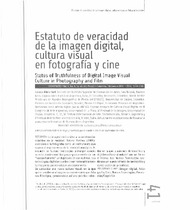| dc.contributor.author | Pérez Tort, Susana | |
| dc.coverage.spatial | Seccional Medellín | spa |
| dc.date.accessioned | 2020-12-10T17:26:14Z | |
| dc.date.available | 2020-12-10T17:26:14Z | |
| dc.date.issued | 2009 | |
| dc.identifier.uri | http://hdl.handle.net/20.500.11912/7183 | |
| dc.description | p. 41 - 50 | spa |
| dc.description.abstract | La imagen icónica sirve a la construcción colectiva de la realidad. Roland Barthes (2005)1 considera a la fotografía como un instrumento que supera el registro veraz de la realidad analógica. Al irrumpir las Nuevas Tecnologías la imagen cambia su estatuto de veracidad ya que puede existir sin ser "necesariamente" un duplicado de esa realidad. Las tecnologías digitales pueden crear matemáticamente imágenes que no existan analógicamente. Se consolida una nueva cultura visual, en la que quien percibe una imagen no cree ni espera que ésta sea fidedigna, generándose así una práctica colectiva en la que la ausencia de veracidad y el fotorrealismo simulado" son un fin en sí mismo. Las Nuevas Tecnologías gestionan un nuevo criterio de percepción y construcción de la realidad. | spa |
| dc.description.abstract | The iconic image serves the collective construction of reality. Roland Barthes (2005)3 considers photography as an instrument that exceeds the true record of analog reality. Because of the breakthrouqh of new technologies, the image changes its status of truthfulness as it can exist without being "necessarily" a duplicate ofthat reality. Digital technologies can mathematically create images that do not exist analogically. A new visual culture is consolidated in which the one who perceives an image does not believe or expect that it is reliable managing, thus, a collective practice in which the lack of truthfulness and simulated photorealisrrr' are an end in itself. New Technologies manage a new standard of perception and construction of reality. | spa |
| dc.format.mimetype | application/pdf | |
| dc.language.iso | spa | |
| dc.publisher | Universidad Pontificia Bolivariana | spa |
| dc.relation.ispartof | Iconofacto | spa |
| dc.rights | Attribution-NonCommercial-NoDerivatives 4.0 International | * |
| dc.rights.uri | http://creativecommons.org/licenses/by-nc-nd/4.0/ | * |
| dc.subject | Imagen digital | spa |
| dc.subject | Fotografía | spa |
| dc.subject | Cine | spa |
| dc.subject | Nuevas tecnologías | spa |
| dc.subject | Percepción/Cognición | spa |
| dc.subject | Digital Imaging | spa |
| dc.subject | Photography | spa |
| dc.subject | Film | spa |
| dc.subject | New Technologies | spa |
| dc.subject | Perception / Cognition | spa |
| dc.title | Estatuto de veracidad de la imagen digital, cultura visual en fotografía y cine | spa |
| dc.title.alternative | Status of Truthfulness of Digital Image Visual Culture in Photography and Film | spa |
| dc.type | article | spa |
| dc.rights.accessRights | openAccess | spa |
| dc.type.hasVersion | publishedVersion | spa |
| dc.description.sectional | Medellín | spa |
| dc.identifier.instname | instname:Universidad Pontificia Bolivariana | spa |
| dc.identifier.reponame | reponame:Repositorio Institucional de la Universidad Pontificia Bolivariana | spa |
| dc.identifier.repourl | repourl:https://repository.unab.edu.co/ | |


